NAME, a free knitting pattern from Knitty.com. Free knitting pattern for a DETAILS HERE.
INTRODUCTION
Autumn's Return
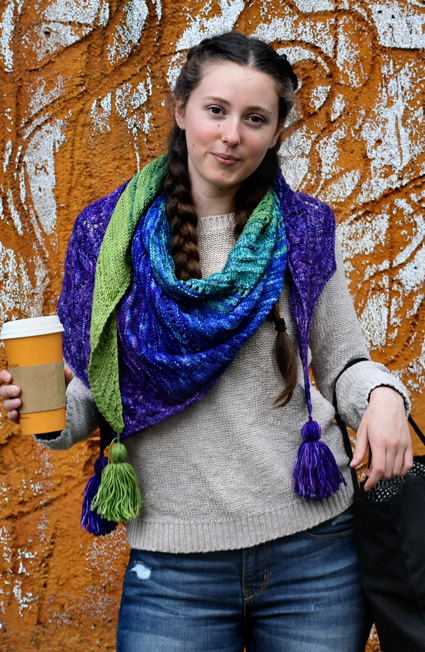 by Stephanie Shiman
by Stephanie Shiman
![]()
I’ve always been fascinated with knitters that keep one project going at a time, following it through to completion before starting another. I, for better or worse, have a project going for every occasion. They’re the small, mindless portable knits that keep my fingers busy during things that require my brain’s attention. The complicated knits are for when I need to take a deep dive into knitting, my escape. There’s even emergency knitting that spends winters in the car with me, because if I get stuck in the snow at least I won’t be bored while I wait for a tow. (Thankfully that project has had very little progress made on it!)
This shawl encompasses the first two perfectly. It starts small, rhythmically mindless — but not boring — the ridges and eyelet rows keep your interest and mark progress. All the while foreshadowing the lace ending; that, while not overly complicated, requires your focus for the exciting finale.
The beginning of the fall season follows a similar pattern. It starts simply – just a hint of color in a tree here or there. The weather takes a little dip in temperature, the light begins to shift. Slowly, the colors of the leaves shift through greens, and reds, and golds until they are all ablaze with the return of autumn.
 models: Shannon Herrick, Mesa Kennedy
models: Shannon Herrick, Mesa Kennedy
 photos: Shannon & Crispin Herrick, Stephanie Shiman
photos: Shannon & Crispin Herrick, Stephanie Shiman
SIZE
One
FINISHED MEASUREMENTS
Width across top: 84 inches/213cm, not including tassels
Depth at center point: 30 inches/76cm
MATERIALS
Yarn
Fade Version (shown above):
![]() CC1-CC5: Wonderland Yarns “Mad Hatter” Mini Skein Pack [100% superwash merino; 430 yd/393 m per 5 oz/142 g skein]; color: Meet in the Middle: 1 pack
CC1-CC5: Wonderland Yarns “Mad Hatter” Mini Skein Pack [100% superwash merino; 430 yd/393 m per 5 oz/142 g skein]; color: Meet in the Middle: 1 pack
![]() C6: Wonderland Yarns “Mad Hatter” [100% superwash merino; 344 yd/315 m per 4 oz/113 g skein]; color: Shimmerness; 1 skein
C6: Wonderland Yarns “Mad Hatter” [100% superwash merino; 344 yd/315 m per 4 oz/113 g skein]; color: Shimmerness; 1 skein
Notes on colors: When choosing colors for a fade, you will get the best results if the colorways chosen are “cousins.” I liked this mini skein pack for fading because it is a spectrum and all the colorways were “cousins”, meaning that they have a lot in common, without being the same. In this case, they’re rich colors, speckled, and have white/natural colored highlights. In the finished garment, the similarities give cohesiveness. For the fade version, I worked the colors in spectrum order: I used the lime green as C1, the olive green for C2, the teal for C3, blue for C4, and blue-purple for C5. C6 is a purple that melds well with the mini skeins.
Single color version (shown below):
![]() Wonderland Yarns “Mad Hatter” [100% superwash merino; 344 yd/315 m per 4 oz/113 g skein]; color: Wildflowers on Your Bedside Table; 2 skeins
Wonderland Yarns “Mad Hatter” [100% superwash merino; 344 yd/315 m per 4 oz/113 g skein]; color: Wildflowers on Your Bedside Table; 2 skeins
Recommended needle size
[always use a needle size that gives you the gauge listed below - every knitter's gauge is unique]
![]() US #6/4mm circular needle, 24/60 cm or longer to accommodate stitches
US #6/4mm circular needle, 24/60 cm or longer to accommodate stitches
Notions
![]() yarn needle
yarn needle
![]() stitch markers to keep track of pattern repeats, if desired
stitch markers to keep track of pattern repeats, if desired
![]() a small (5-7 inches/12.5-17.5cm) piece of cardboard or equivalent to wrap yarn around to make tassels, if desired
a small (5-7 inches/12.5-17.5cm) piece of cardboard or equivalent to wrap yarn around to make tassels, if desired
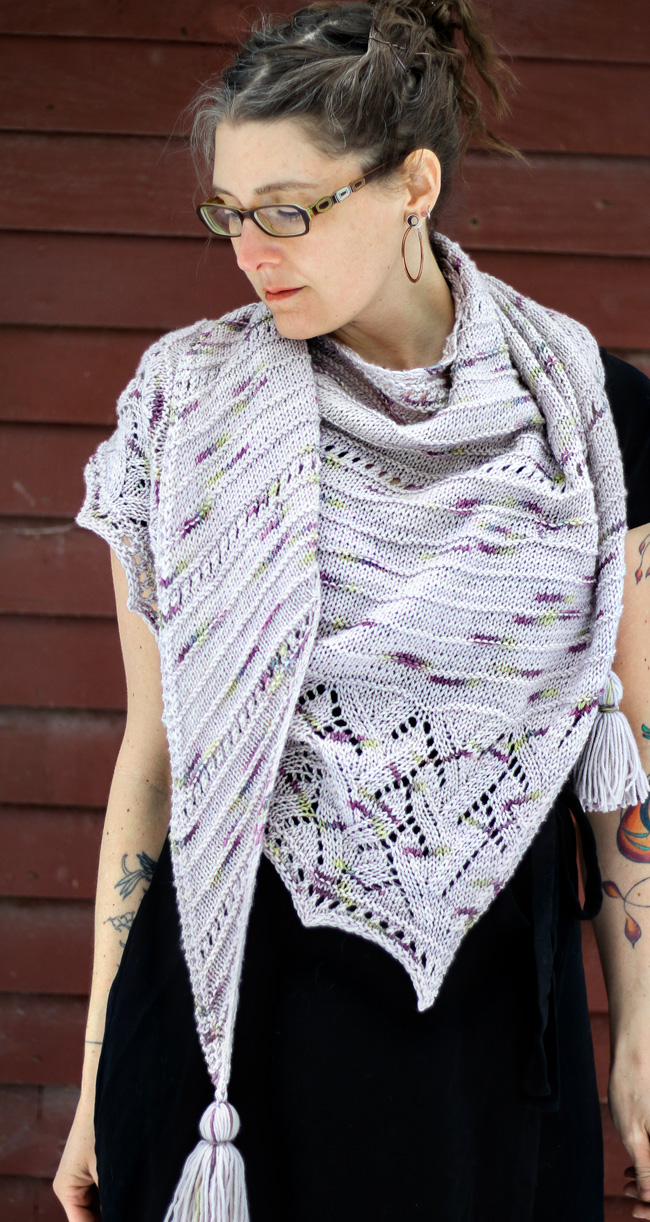
GAUGE
17 sts/24 rows = 4 inches/10 cm in ridged pattern stitch, after blocking
17 sts/26 rows= 4 inches/10 cm in stockinette stitch, after blocking
PATTERN NOTES
[Knitty's list of standard abbreviations and techniques can be found here.]
The first part of the shawl is knit on the bias in stockinette stitch with purl ridges, interspersed with eyelet sections. Once the full width is reached, a large lace pattern gives a grand finish.
Color fade:
You should work with each color until you’re near to running out, and then bring in the next one. Start a Fade sequence on any WS row of Pattern A, or on Row 6 of Pattern B.
To work a fade, join the next color, [work 2 rows in pattern in new color, work 2 rows in pattern in existing color] twice, then cut the existing/previous color, and continue with the new one.
You need about 3-4 times the length of a row in yarn to work it, so you need to start the transition when you’ve got at minimum 4 rows’ worth of the old color – about 12-16 times the length of the row if you’re measuring that way. If you have a very accurate digital scale, you can also weigh the yarn to see how much you need for four rows. Work Fades throughout.

Tassels
If you’d like your shawl to have tassels, make one with C1 before starting, that way you can work with C1 without needing to worry about saving leftovers. See Finishing instructions for details on how to make the tassels.
Bind Off
Either bind off with a larger needle or use a stretchy method like Jeny’s Surprisingly Stretchy Bind-Off.
Pattern A
Row 1 [RS]: K2, yo, k1, yo, k to last 4 sts, k2tog, k2. 1 st increased.
Row 2 [WS]: K2, p to last 2 sts, k2.
Row 3 [RS]: K2, yo, k1, yo, k to last 4 sts, k2tog, k2. 1 st increased.
Row 4 [WS]: Knit.
Row 5 [RS]: K2, yo, k1, yo, k to end. 2 sts increased.
Row 6 [WS]: K2, p to last 2 sts, k2.
Pattern B
Row 1 [RS]: K2, yo, k1, yo, (k2tog, yo) to last 3 sts, k3. 2 sts increased.
Row 2 [WS]: K2, p to last 2 sts, k2.
Row 3 [RS]: K2, yo, k1, yo, k to last 4 sts, k2tog, k2. 1 st increased.
Row 4 [WS]: Knit.
Row 5 [RS]: K2, yo, k1, yo, k to last 4 sts, k2tog, k2. 1 st increased.
Row 6 [WS]: K2, p to last 2 sts, k2.
CHARTS
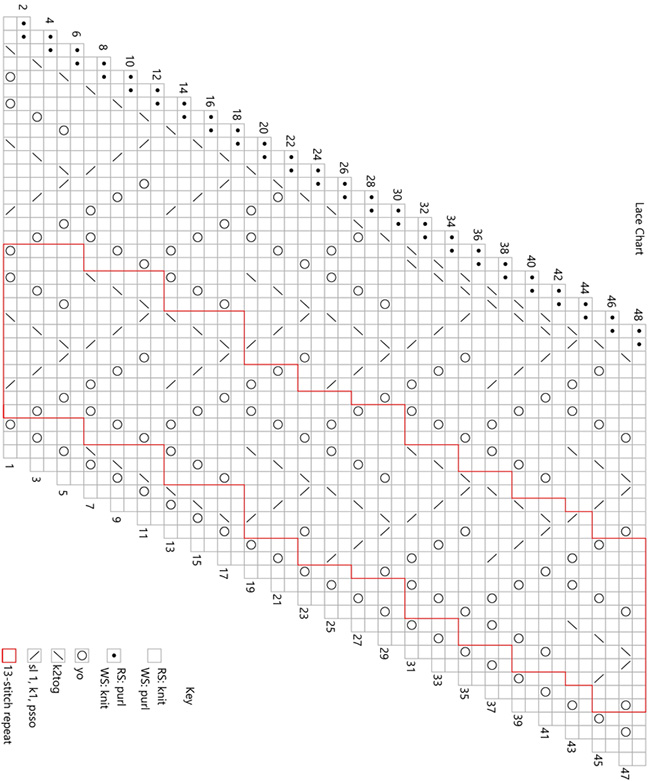
Note: Right-click to download and print, if a sideways digital chart is too annoying to work from.
DIRECTIONS
Using the long-tail method, and C1, CO 4 sts.
Setup
Row 1 [RS]: K2, yo, k1, yo, k1. 6 sts.
Row 2 [WS]: K2, p2, k2.
Row 3 [RS]: K2, yo, k1, yo, k3. (8 sts.
Row 4 [WS]: K2, p to last 2 sts, k2.
Body of Shawl
Work Pattern A three times. 20 sts.
Work Pattern B. 24 sts.
Work Pattern A three times. 36 sts.
Work Pattern B once. 40 sts.
Work Pattern A four times. 56 sts.
Work Pattern B once. 60 sts.
Work Pattern A five times. 80 sts.
Work Pattern B once. 84 sts.
Work Pattern A five times. 104 sts.
Work Pattern B once. 108 sts.
Work Pattern A six times. 132 sts.
Work Pattern B once. 136 sts.
Work Pattern A six times and work Rows 1-4 once more.
Next row [RS]: K2, yo, k1, yo, k to last 4 sts, k2tog, k2. 163 sts.
Following row: K2, p to last 2 sts, k2
At this point, change to C6 if you haven’t already, and complete the shawl with C6. From this point forward, increases and decreases will keep the work on the bias, but the stitch count will not change.
Lace Section
Row 1 [RS]: Work Lace Section Chart across, working 13-st repeat 11 times.
Work as set until all 48 rows of chart are complete, increasing the number of repeats of the main pattern as required.
Final Rows
Row 1 [RS]: K2, yo, k to last 4 sts, k2tog, k2.
Row 2 [WS]: Knit.
Row 3 [RS]: K2, yo k to last 4 sts, k2tog, k2.
Row 4 [WS]: K2, p to last 2 sts, k2.
Row 5 [RS]: K2, yo, (k2tog, yo) to last 4 sts, k2tog, k2.
Row 6 [WS]: K2, p to last 2 sts, k2.
Loosely BO purlwise, using your preferred stretchy method.
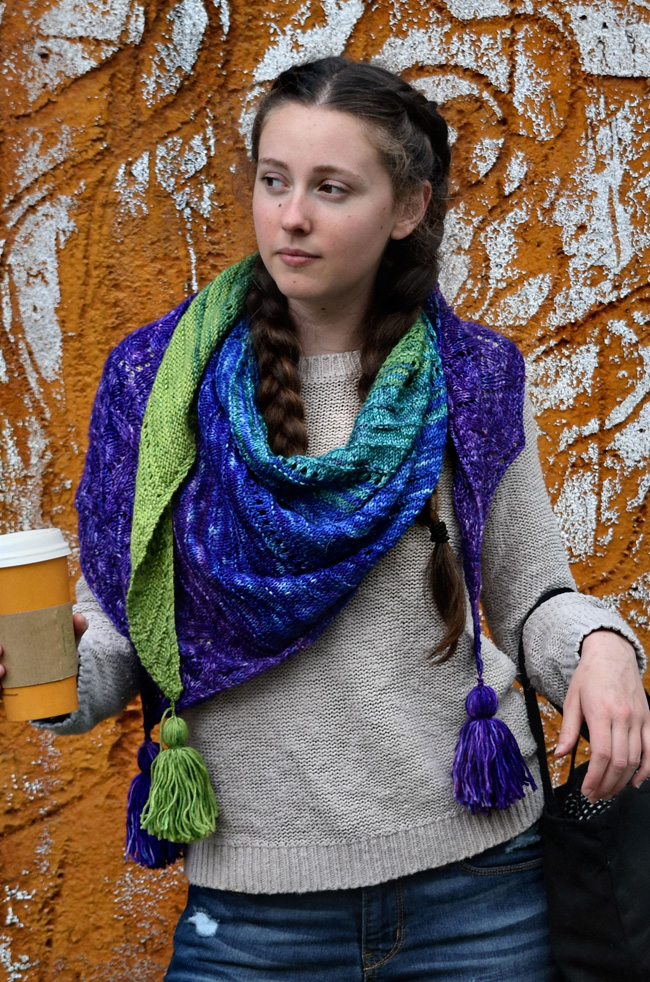
FINISHING
Use remaining yarn to make tassels, if desired. The sample shows two tassels wrapped approximately 60 times around a piece of cardboard measuring 5 inches/12.5 cm.
Weave in ends, leaving tails to be snipped after blocking. Block shawl, pinning out points, and allow to dry completely. Snip yarn tails. Attach tassels.
ABOUT THE DESIGNER
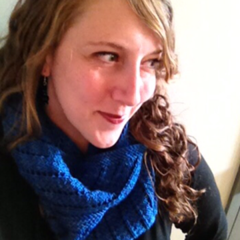 Stephanie’s first pattern for Knitty was “Unbiased” in the fall of 2004. As soon as the issue went live, her inbox was filled with emails from knitters looking for the yarn she had used. So, with a box of recycled silk yarn under her dining room table, Frabjous Fibers was born. Fifteen years later, Stephanie and her team of creatives fill 7,000 square feet with color and texture. Little did she know the path that one design would lead her down and she’s been grateful every step of the way.
Stephanie’s first pattern for Knitty was “Unbiased” in the fall of 2004. As soon as the issue went live, her inbox was filled with emails from knitters looking for the yarn she had used. So, with a box of recycled silk yarn under her dining room table, Frabjous Fibers was born. Fifteen years later, Stephanie and her team of creatives fill 7,000 square feet with color and texture. Little did she know the path that one design would lead her down and she’s been grateful every step of the way.
Stephanie (stefknits on Ravelry) is the owner of frabjous fibers and Wonderland Yarns. When she’s not up to her elbows in dye, she enjoys foolishness with her daughters, junk shops, pottery, and all manner of fiber crafts.
Pattern & images © 2019 Stephanie Shiman